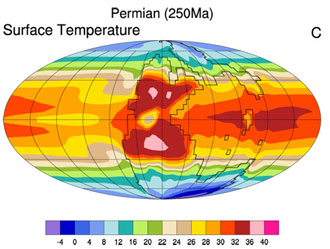Poisonous volcanic gas probably caused worst mass extinction says new study
mongabay.com
December 2, 2005
The mass extinction event at the end of the Permian — where more than two-thirds of reptile and amphibian families perished and 95% of oceans life forms became extinct — was probably caused by poisonous volcanic gas, according to research published in the journal Geology. The researchers believe that volcanic gases from the eruption, near present day Siberia, depleted earth’s protective ozone layer and acidified the land and sea.
The study supports research presented in the September issue of Geology which argued that a dramatic rise in carbon dioxide 250 million years ago may have caused global temperatures to soar and result in Earth’s greatest mass extinction. The new study analyzed polysaccharides, large sugar-based structures common in plants and soil, found in rocks from the Dolomites in Italy, while the earlier National Center for Atmospheric Research modeled changes in atmospheric concentrations of CO2 and ocean waters. A massive volcanic eruption could well have increased carbon dioxide in the atmosphere which would have warmed and acidified oceans.
Today scientists are increasingly concerned by ocean acidification which threatens marine species that rely on calcium carbonate shells and skeletons. Researchers recently warned that due to increasingly ocean acidity and rising sea temperatures, most of the world’s coral reefs could die by the end of the century.
No safe ground for life to stand on during world’s largest mass extinction.
Imperial College London release
December 2, 2005
The world’s largest mass extinction was probably caused by poisonous volcanic gas, according to research published today.
The research, published in the journal Geology, reveals vital clues about the mass extinction at the end of the Permian period, 250 million years ago, when mammal-like reptiles known as synapsids roamed the earth.
 This image shows annual mean surface temperatures in degrees Celsius at the time of the Permian extinction. It is based on a computer simulation generated by the Community Climate System Model at NCAR. (Illustration courtesy Jeff Kiehl, NCAR.) |
Many scientists had previously thought that an asteroid hitting the earth or a deep-sea methane release had caused the extinction, which obliterated more than two-thirds of reptile and amphibian families.
However, analysis of a unique set of molecules found in rocks taken from the Dolomites in Italy has enabled scientists to build up a picture of what actually happened. The molecules are the remains of polysaccharides, large sugar-based structures common in plants and soil, and they tell the story of the extinction.
The molecules date from the same time as a major volcanic eruption that caused the greatest ever outpouring of basalt lava over vast swathes of land in present day Siberia.
The researchers believe that the volcanic gases from the eruption, which would have depleted earth’s protective ozone layer and acidified the land and sea, killed rooted vegetation. This meant that soil was no longer retained and it washed into the surrounding oceans.
|
The chemistry of the rocks reveals that although the sugar molecules were found in marine sediments, they derived from land, supporting the theory that massive soil erosion caused them to end up in the sea.
Soil materials in the oceans would have blocked out light and soaked up oxygen. Analysis of rock chemistry suggests that after the soil crisis on land, the marine ecosystem succumbed to the stresses of environmental change and oceanic life faltered, completing a global catastrophe.
Dr Mark Sephton, from Imperial College London’s Department of Earth Sciences and Engineering and lead author of the research, said: “The cause of the end Permian extinction has been highly controversial. We show that the terrestrial ecosystem was the first to suffer. The continent-wide nature of the event implies that it was caused by something in the atmosphere. The unique chemical data indicates that something fast and catastrophic happened on land.”
Prof Henk Visscher of Utrecht University, also part of the research team, commented: “Similar to the ‘Dead Zone’ nowadays spreading in the Gulf of Mexico, the soil crisis could have caused a worldwide expanse of uninhabitable low-oxygen conditions in shallow marine waters. So what began on land ended in the sea. It seems there was no place to hide at this time of great dying.”
Dr Sephton believes that lessons can be learned in the present day from the damage caused by the end Permian extinction: “Land degradation is a worsening global problem thanks to human activity and soil erosion has caused the loss of a third of arable land over the last forty years. 35% of the Earth’s land is now soil-free. Identifying the nature of the end Permian soil crisis may help us understand what is in store for us in the years ahead,” he said.
The research was carried out by an international team of scientists from the United Kingdom, the Netherlands and the United States.
This story contains a modified news release from the Imperial College London. The original version appears at No Safe Ground For Life To Stand On During World’s Largest Mass Extinctionsts
